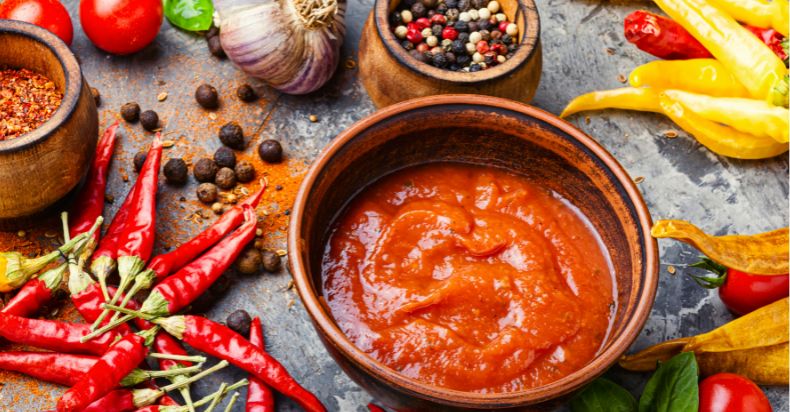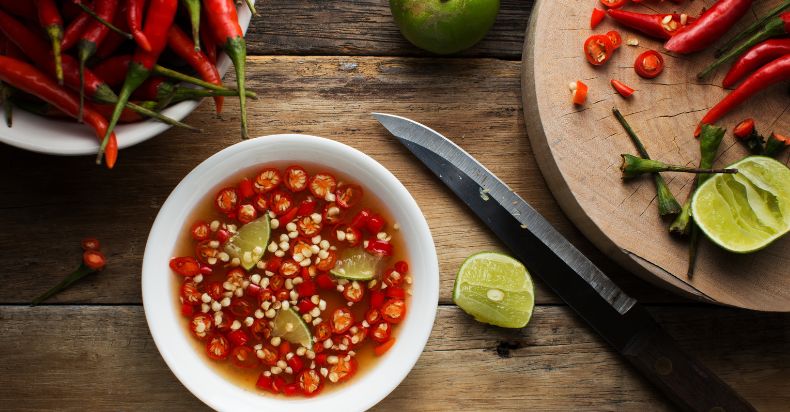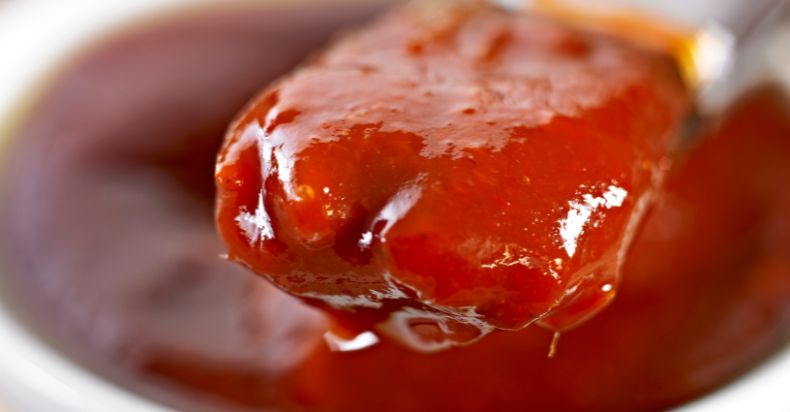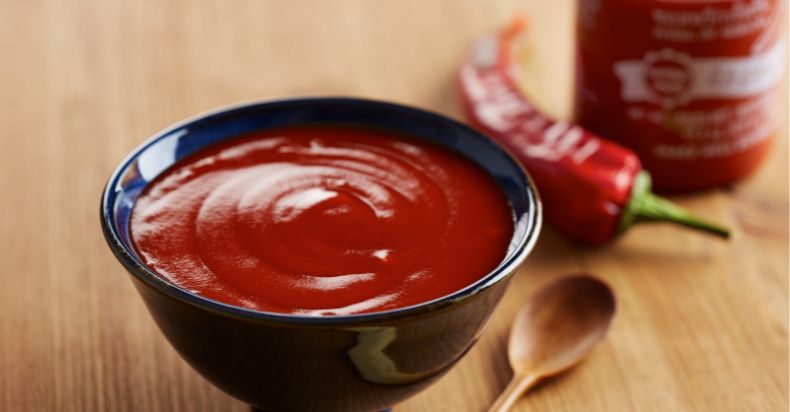Have you ever stumbled upon a vibrant red sauce called chamoy and wondered what all the fuss is about? Well, you’re in for a treat! Chamoy is not just a condiment, it’s a taste sensation that’s taking the culinary world by storm.
From its sweet, sour, salty, and spicy symphony of flavors to its rich cultural roots, chamoy is a culinary gem waiting to be discovered. Whether you’re a spice-loving veteran or a curious foodie, this article will take you on a chamoy adventure like no other.
Vegan? We’ve got you covered too! So buckle up, grab a spoon, and let’s dive into the wild and wonderful world of chamoy!
What is Chamoy?

Chamoy is not just a condiment, it’s a taste sensation! Originating from Mexico, chamoy is a delightful blend of sweet, sour, salty, and spicy flavors. At its core, chamoy is made from pickled fruit like apricots or plums, combined with chili peppers, lime juice, and salt. But wait, there’s more![source]
Variations of Chamoy: From Mild to Spicy
Chamoy comes in various forms and intensities. You can find it as a liquid sauce, a paste, or even a powdered seasoning. Whether you’re a spice newbie or a heat-seeking veteran, there’s a chamoy for you.
Some versions are mild and tangy, while others will set your taste buds on fire!
Chamoy’s Place in Mexican Cuisine
Chamoy isn’t just a random sauce; it’s a staple in Mexican cuisine. It’s like the salsa’s adventurous cousin that’s always up for a good time.
You’ll find chamoy in street food stalls, fancy restaurants, and even in Mexican households. It’s used in snacks, drinks, and main dishes, adding a unique twist to traditional recipes.
The Origin of Chamoy: A Brief History

Asian Roots and Mexican Transformation
Now, let’s take a trip back in time. Chamoy’s story begins in Asia, where a similar sauce was made from pickled fruit.
When it reached Mexico, it got a spicy makeover, and the chamoy we know and love was born. It’s like a culinary fusion dance that created a masterpiece.
Evolution of Chamoy Over Time
Chamoy has evolved over the years, with different regions in Mexico adding their unique touch.
From family recipes passed down generations to commercial brands, chamoy has grown in popularity and diversity.
It’s not just a sauce; it’s a symbol of Mexican creativity and innovation.
Cultural Significance in Mexico
In Mexico, chamoy is more than a condiment; it’s a part of the cultural fabric.
It represents the Mexican love for bold flavors and the ability to turn simple ingredients into something extraordinary.
Whether at a family gathering or a local fiesta, chamoy is there, adding joy and zest to every bite.
So, are you intrigued by chamoy yet? This saucy sensation is waiting for you to explore, taste, and fall in love with. Stay tuned as we dive deeper into the world of chamoy in the next sections!
What is Chamoy Made Out Of?

Chamoy, that tantalizing taste sensation, is a culinary masterpiece made from a delightful blend of ingredients. But what exactly goes into this vibrant red sauce? Let’s break it down, ingredient by ingredient, and uncover the magic behind chamoy.
Traditional Ingredients: The Core of Chamoy
- Pickled Fruit: The heart and soul of chamoy is pickled fruit, often apricots, plums, or mangos. It’s like the sweet melody in a rock song, setting the stage for the other flavors to shine.
- Chili Peppers: Adding the heat and kick, chili peppers are the spicy backbone of chamoy.
- Lime Juice: The tangy twist in chamoy comes from lime juice.
- Salt: Balancing the sweet and sour, salt is the unsung hero of chamoy.
Variations and Additions: Chamoy’s Many Faces
Chamoy is a versatile sauce, and different recipes might include additional ingredients to create unique flavor profiles.
- Tamarind (Chamoy Tamarindo): Some variations of chamoy, known as chamoy tamarindo, include tamarind paste, adding a tangy and exotic twist to the flavor.
- Spices: Some chamoy recipes include spices like cumin or ancho chili powder, adding depth and complexity.
- Sweeteners: To enhance the sweetness, some chamoy might include sugar or honey.
- Non-Vegan Components: Beware, vegan friends! Some commercial chamoy might include shrimp paste or fish sauce. Always check the label or opt for vegan alternatives.
Whether you enjoy it in its traditional form or explore variations, chamoy invites you to savor its multifaceted flavors and embark on a culinary adventure like no other.
The Taste of Chamoy: What Does Chamoy Taste Like?

Alright, flavor explorer, let’s dive into the taste of chamoy! Imagine a symphony where sweet, sour, salty, and spicy notes all play together in perfect harmony.
That’s chamoy for you! It’s like a party in your mouth where every flavor is invited, and no one wants to leave.
Chamoy isn't just about taste; it's a full sensory experience. Depending on how it's made, chamoy can be thick and velvety or thin and tangy.
Its vibrant red color is a feast for the eyes, and its texture can range from smooth to chunky. It’s like a chameleon of flavors, always surprising and delighting.
Wondering what to pair with chamoy? Oh, the possibilities are endless! Chamoy loves to mingle with fruits like mango and pineapple, adding a zesty twist.
It’s also a perfect match for salty snacks like chips and pretzels. Chamoy is like that friend who gets along with everyone at the party; it just fits in.
Common Uses of Chamoy in Cuisine:
Chamoy in Snacks: A Street Food Favorite
Take a stroll down a Mexican street, and you’ll find chamoy everywhere!
From chamoy fruta, where fresh fruits like mango, pineapple, or watermelon are drizzled with chamoy, to spicy candies, it’s a street food favorite.
The combination of sweet fruit with tangy and spicy chamoy creates a flavor explosion that’s both refreshing and exciting.
Ever tried a chamoy-dipped apple? If not, your taste buds are missing out on a carnival of flavors!
Chamoy in Drinks: A Splash of Excitement
Chamoy isn’t shy; it loves to make a splash in drinks too! From chamoy-rimmed margaritas to refreshing chamoy-infused lemonades, it adds a kick that’s both surprising and delightful.
And let’s not forget the famous chamoy michelada, a spicy beer cocktail that’s taken to the next level with a generous swirl of chamoy.
It’s like the life of the beverage party, turning ordinary drinks into extraordinary sips.
Chamoy in Main Dishes: Elevating Flavors
Think chamoy is just for snacks and drinks? Think again! Chefs are using chamoy to elevate main dishes, adding a unique twist to recipes.
Whether it’s a glaze for grilled vegetables or a sauce for seafood, chamoy brings a new dimension to the dining experience.
It’s like the secret ingredient that makes everything taste better.
Is Chamoy Vegan?

So, you’ve fallen in love with chamoy, but you’re wondering, “Is it vegan?” Let’s dissect this saucy sensation!
Yes, traditional chamoy is vegan friendly, as it is made from pickled fruit, chili peppers, lime juice, and salt.
However, some commercial chamoy might contain non-vegan ingredients like shrimp paste or fish sauce. It’s like finding out your favorite superhero wears socks with sandals – a bit disappointing.
But don’t lose hope; there are still plenty of vegan-friendly options!
When shopping for chamoy, keep an eye on those labels. Look for words like “vegan” or check the ingredients for any hidden non-vegan components. It’s like being a flavor detective, searching for clues to ensure your chamoy is cruelty-free.
The good news is that many brands offer vegan chamoy, free from any animal-ingredients.
But, if you are feeling crafty, why not make your own vegan chamoy at home? With some pickled fruit, chili powder, lime juice, and a pinch of creativity, you can whip up a vegan chamoy that’s as tasty as it is ethical.
It’s like being a culinary artist, painting flavors with a compassionate brush.
If you’re dining out, ask your server about vegan chamoy options or look for restaurants that cater to plant-based diets.
Is Chamoy Halal?
The halal status of chamoy depends on the ingredients used to make it. Traditional chamoy is made from natural ingredients like fruit, chiles, and lime, which are generally considered halal.
However, some commercially produced chamoy may contain ingredients that are not halal, such as alcohol-based flavorings or preservatives.
If you are looking for halal chamoy, it is important to check the label for any non-halal ingredients or look for a product that is specifically labeled as halal.
Additionally, you can make chamoy at home using halal ingredients to ensure it meets your dietary requirements.
Where to Buy Chamoy: A Shopper’s Guide
So you’ve fallen in love with chamoy, and now you’re thinking, “I love chamoy, where to buy?” Don’t worry, fellow chamoy enthusiast; I’ve got you covered!
Whether you’re looking for traditional chamoy, chamoy tamarindo, or vegan alternatives, there are plenty of places to find this tantalizing sauce.
Supermarkets and Grocery Stores
Many large supermarkets and specialty grocery stores carry chamoy in their international or Hispanic food sections.
Look for different brands and variations, including chamoy fruta and chamoy michelada mixes.
Online Retailers
If you prefer shopping from the comfort of your home, numerous online retailers offer chamoy.
From popular e-commerce sites (link this one) to specialized Mexican food stores, you can find a wide selection of chamoy products, including unique flavors and vegan options.
Local Mexican Markets
For an authentic experience, visit local Mexican markets or tiendas.
These stores often carry traditional and homemade chamoy, giving you a taste of true Mexican flavors.
Don’t be shy to ask for recommendations; the staff might introduce you to a new favorite!
Farmers’ Markets and Street Vendors
In some areas, you might find chamoy at farmers’ markets or sold by street vendors.
These options often provide fresh and artisanal chamoy, crafted with love and passion. It’s like discovering a hidden gem in your local community.
Happy chamoy hunting, and may your taste buds embark on an unforgettable journey!
Conclusion
So there you have it, the vegan’s guide to chamoy! Whether you’re shopping, dining out, or cooking at home, there’s a vegan chamoy option for you. Embrace the flavors, enjoy the taste, and celebrate the fact that chamoy can be a part of your plant-based journey.
Remember, chamoy is not just a sauce; it’s a world of flavors waiting to be explored. Vegan or not, chamoy invites you to taste, savor, and fall in love with its unique blend of sweet, sour, salty, and spicy notes.
So grab a bottle, a spoon, or a recipe, and let chamoy take you on a flavor adventure that’s as compassionate as it is delicious!
FAQs
How long does chamoy last?
Chamoy can last for several weeks in the refrigerator if stored in an airtight container. Commercially packaged chamoy will have an expiration date on the label.
Is chamoy sauce spicy?
Chamoy sauce can be spicy, but the level of heat varies depending on the recipe and brand. Some chamoy is mildly tangy, while others pack a spicy punch.
What is chamoy and Tajin good on?
Chamoy and Tajín are versatile and can be used on a variety of foods.
They’re great on fresh fruits, snacks, drinks like chamoy michelada, and even main dishes for a zesty twist.
How to make thick chamoy?
To make thick chamoy, you can reduce the liquid content or add a thickening agent like cornstarch.
Cooking the chamoy over low heat until it reaches the desired consistency can also help thicken it.
Does chamoy taste like Tajín?
While chamoy and Tajín both have tangy and spicy flavors, they are distinct.
Chamoy is a sauce made from pickled fruit, chili peppers, and other ingredients, while Tajín is a chili-lime seasoning powder.
Can I make chamoy at home?
Absolutely! There are plenty of recipes online to help you make your own vegan or traditional chamoy.
Here’s an easy recipe:
